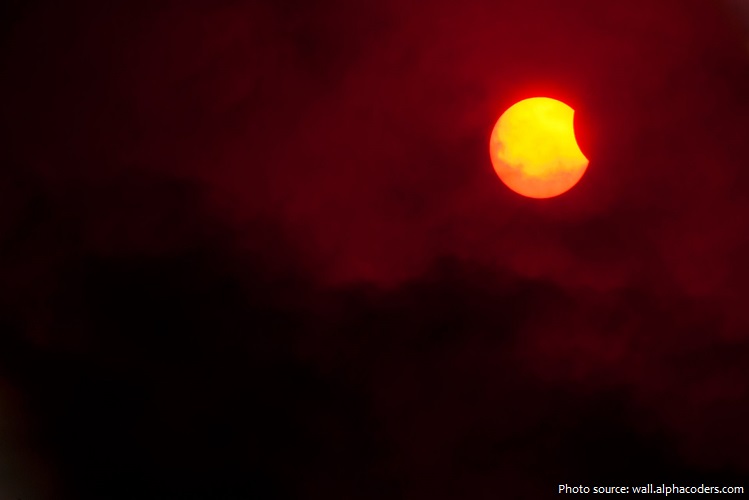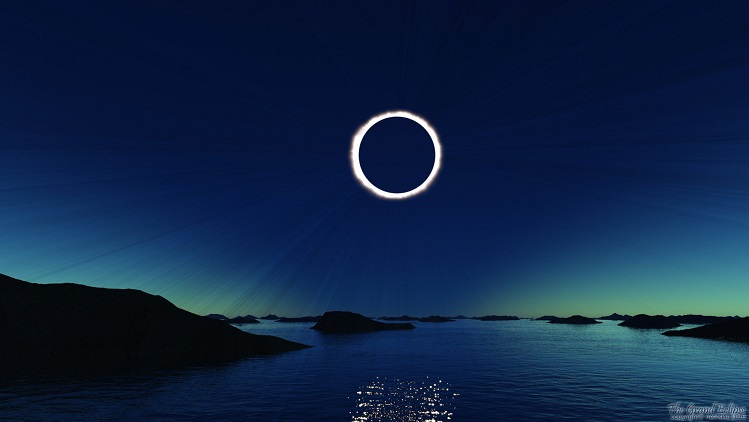
A solar eclipse occurs when the moon gets between Earth and the sun, and the moon casts a shadow over Earth.
It can only take place at the phase of new moon, when the moon passes directly between the sun and Earth and its shadows fall upon Earth’s surface.
There are four types of solar eclipses: a total eclipse, an annular eclipse, a hybrid eclipse and a partial eclipse.
A total eclipse occurs when the Sun is completely obscured by the Moon. The intensely bright disk of the Sun is replaced by the dark outline of the Moon, and the much fainter corona is visible. During any one eclipse, totality is visible only from at most a narrow track on the surface of the Earth.

An annular eclipse occurs when the Sun and Moon are exactly in line, but the apparent size of the Moon is smaller than that of the Sun. Hence the Sun appears as a very bright ring, or annulus, surrounding the outline of the Moon.
A hybrid eclipse is intermediate between a total and annular eclipse. At some points on the surface of the Earth it is visible as a total eclipse, whereas at others it is annular. Hybrid eclipses are rather rare.
A partial eclipse occurs when the Sun and Moon are not exactly in line, and the Moon only partially obscures the Sun. This phenomenon can usually be seen from a large part of the Earth outside of the track of an annular or total eclipse. However, some eclipses can only be seen as a partial eclipse, because the umbra never intersects the Earth’s surface.

Between two and five total or partial solar eclipses happen every year. Whether or not you see a full or partial eclipse depends on where you are on Earth. A full eclipse may be visible to people in the Northern Hemisphere when it is facing the sun, for example. In this situation, people in the Southern Hemisphere will not see the eclipse at all.
The following factors determine the duration of a total solar eclipse:
• The Moon being almost exactly at perigee (making its angular diameter as large as possible).
• The Earth being very near aphelion (furthest away from the Sun in its elliptical orbit, making its angular diameter nearly as small as possible).
• The midpoint of the eclipse being very close to the Earth’s equator, where the rotational velocity is greatest.
• The vector of the eclipse path at the midpoint of the eclipse aligning with the vector of the Earth’s rotation (i.e. not diagonal but due east).
• The midpoint of the eclipse being near the subsolar point (the part of the Earth closest to the Sun).

The longest eclipse that has been calculated thus far is the eclipse of July 16, 2186 (with a maximum duration of 7 minutes 29 seconds over northern Guyana).
Total solar eclipses are rare events. Although they occur somewhere on Earth every 18 months on average, it is estimated that they recur at any given place only once every 360 to 410 years, on average.
The Moon is just the right size to perfectly cover the sun. The sun is actually many, many, many, times larger than the Moon, but the Moon is much closer to the Earth, so it appears larger.
An eclipse is a natural phenomenon. However, in some ancient and modern cultures, solar eclipses were attributed to supernatural causes or regarded as bad omens. A total solar eclipse can be frightening to people who are unaware of its astronomical explanation, as the Sun seems to disappear during the day and the sky darkens in a matter of minutes.

Historical eclipses are a very valuable resource for historians, in that they allow a few historical events to be dated precisely, from which other dates and ancient calendars may be deduced.
A solar eclipse of June 15, 763 BC mentioned in an Assyrian text is important for the chronology of the ancient Near East. There have been other claims to date earlier eclipses.
The Book of Joshua 10:13 describes the sun staying still for an entire day in the sky – a group of University of Cambridge scholars concluded this to be the annular solar eclipse that occurred on 30 October 1207 BC.
The Chinese king Zhong Kang supposedly beheaded two astronomers, Hsi and Ho, who failed to predict an eclipse 4,000 years ago.

Perhaps the earliest still-unproven claim is that of archaeologist Bruce Masse, who putatively links an eclipse that occurred on May 10, 2807 BC with a possible meteor impact in the Indian Ocean on the basis of several ancient flood myths that mention a total solar eclipse.
The first known telescopic observation of a total solar eclipse was made in France in 1706. Nine years later, English astronomer Edmund Halley accurately predicted and observed the solar eclipse of May 3, 1715.
Solar eclipses are usually named for their darkest, or maximum, point. The exception is the hybrid eclipse.
Never look directly at the Sun, eclipsed or otherwise, without any protective eyewear. The Sun’s radiation can burn the retinas in your eyes leading to permanent damage or even blindness.
The best way to safely watch a total solar eclipse is to wear protective eclipse glasses or to project an image of the eclipsed Sun using a pinhole projector.
